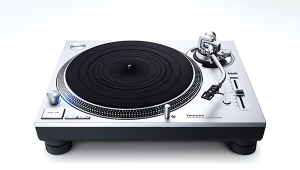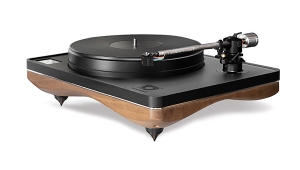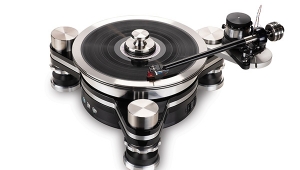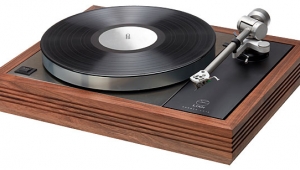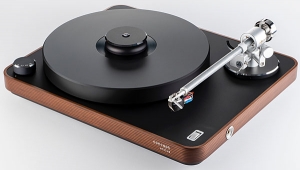| Columns Retired Columns & Blogs |
Linn Sondek LP12 turntable with Lingo power supply Page 2
As my sample Lingo was too early in production to be supplied with a manual and I was on vacation when Audiophile Systems' Steve Daniels installed it, I had to work out for myself how it works. Here's what this tired old brain gathered: A brief push on the LP12's new push-switch results in the red LED lighting and the platter starting to rotate (with a bit of judder). When the platter reaches speed, the LED dims slightly as the Lingo output changes from high-torque mode to speed-maintenance mode. A second brief push cuts off power to the motor, though the LED doesn't extinguish until after the platter has stopped rotating. Holding your finger on the push-switch results in first the red LED lighting, then to be replaced by the green as the Lingo understands that you want the higher speed. Again, the green LED dims as the platter reaches 45rpm, and a brief push turns off the supply to the motor.
Footnote 2: The LP12's ability to sell itself in dealers' listening rooms continues. In 1988, my late stepfather wanted to buy the best system he could for his retirement. He studied all the magazines, he asked dealers, he even asked me. He was told by just about everyone that CD was the medium he should base his new system on. He therefore went out one day to buy a CD player; he came back with a Sony player and a Linn.—John Atkinson
Sound
Sound? Of a turntable? Gedoudadown!
That was pretty much the reaction of audiophiles in the mid-1970s (were they called "audiophiles" back then?) when the pinnacle of circular LP performance was supposed to be a Technics SP10. Or a Sony TTS-3000. Or—I'm not making this up—a Kenwood KD-500. And if you read a few pickup cartridge reviews from that time, they sometimes mention the tonearm used but never the turntable.
Then came Ivor and his amazing magic show. There wasn't a hi-fi exhibition in the world in the late '70s where Linn's Ivor Tiefenbrun wasn't to be found demonstrating his Sondek LP12, showing that it sounded better than a direct-drive Technics fitted with the same arm and cartridge, that the Sondek fitted with a cheap arm and cartridge sounded better than an inexpensive turntable fitted with an expensive arm and cartridge, that the natural hierarchy was therefore to get the best turntable you could afford, then the tonearm, then the cartridge, then the amplifier and preamplifier, and finally the loudspeaker.
Despite guffaws from those who pointed out that the reductio ad absurdum conclusion of this philosophy was to put together a system that consisted of a Linn and an AM radio, it didn't take me long to be convinced. Unlike test instruments, your ears don't lie. In late '77 I bought the first in what was to be a series of Sondeks. I wasn't alone. Apparently some 80,000 LP12s have been sold since the turntable's introduction in 1974 or so, its users convinced of its positive effect on the sound of any system in which it is used (footnote 2).
Although, as with any long-lived product, there has been a continuous series of minor improvements in the Sondek as the manufacturer learns how to make the product better, there have only been three major changes in the design. The first was dubbed the Nirvana mod, which consisted of a new set of suspension springs and bolts; the second was the addition of a the Valhalla board; and the third was the replacement of the welded-steel subchassis by one that is glued together, and the original fiberboard armboard by one made from a laminated material.
The general trend shown by these improvements and changes was to render the LP12's performance much more stable over time and to reduce its propensity for upper-bass murk. Although I've tried other turntables in my system, notably the original Oracle with Sumiko's The Arm and the SOTA Star Sapphire with the ET2 arm, I've always ended up returning to the Linn, its ability to portray the musical values within recordings outweighing the fact that other turntables can be shown to have better performance in one or more specific areas.
Your glass filled? Well, here's to Casey and Angela. Now, on with the review.
Involvement
I won't list the ancillary equipment I used during my auditioning of the Lingo other than to note that I used it for my last three issues' worth of equipment reviewing with the LP12/Ekos/Troika sitting on the ArchiDee table. I must note, however, that it gave me the impetus to finally get round to retubing my Audio Research SP10—that's one fine phono preamp!
Footnote 2: The LP12's ability to sell itself in dealers' listening rooms continues. In 1988, my late stepfather wanted to buy the best system he could for his retirement. He studied all the magazines, he asked dealers, he even asked me. He was told by just about everyone that CD was the medium he should base his new system on. He therefore went out one day to buy a CD player; he came back with a Sony player and a Linn.—John Atkinson
- Log in or register to post comments
